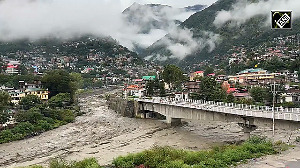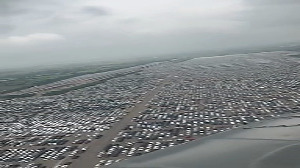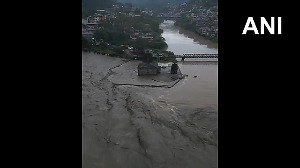"Woking [McLaren headquarters in Surrey] , you've got a problem."
The message being beamed back to McLaren headquarters after the first three long-haul races of the Formula One season is clear enough.
The car that was meant to turn Kimi Raikkonen into a world-beater this year has yet to get the Finn anywhere near a chequered flag.
| |||||||||||
Leaving aside the sight of Raikkonen coasting around with a sheet of flame shooting out of the back of his car in Bahrain at the weekend, the statistics tell the story.
The last team to win a title before Ferrari and Michael Schumacher got into the domination game, McLaren have scored just four points. Last year they had 39 by now.
But under the old scoring system, rewarding just the top six finishers, McLaren would have scored only one point -- a situation little better than 1981 when they drew a blank in the opening three races.
McLaren have covered the least race mileage of all 10 teams and Raikkonen, overall runner-up to Schumacher last year, was the first to retire in Australia and Bahrain.
Last weekend, they were the only team that failed to get at least one car to the finish.
When asked about the team's title chances after Bahrain, Briton David Coulthard simply shook his head. The dream, he said, was to win a race this year. The rest was about as real as a mirage.
CRISIS MANAGEMENT
McLaren must now identify the problem and that is not proving easy.
"The most truthful answer is, I don't know," said team boss Ron Dennis when asked whether McLaren had a generic problem that had fed through from the ill-fated MP4-18 that was built last year but never raced or whether they were just short-term glitches.
"And if I did, we would address it.
"The fact is that the car, at certain circuits, is incredibly quick.
"And that is very confusing. We have narrowed down the areas of weakness, those areas where the car is not particularly quick or provides the driver with a degree of uncertainty about its position on the road."
There has been an element of bad luck involved, with Dennis pointing out that Raikkonen's retirement in Australia was caused by a pinhole leak in a water radiator.
In Malaysia the team paid the price for a start strategy that overloaded Raikkonen's drive train. They got it wrong and took the blame.
In Bahrain, Coulthard's car was pitched off track in practice by a brake failure.
"That disc that failed is the first disc of its type that has failed in Formula One ever and there's three or four teams that use it," said Dennis.
While the engine has attracted criticism after visible failures, such as Raikkonen's on Sunday, the fear is that the problems may also be organisational.
"Inevitably when things are not going well people analyse what goes on," said Coulthard, himself due to be replaced by Colombian Juan Pablo Montoya next year.
"There is always some good to come out of these situations. You get rid of the dead wood and you go forward."
Although technical director Adrian Newey is one of the most respected designers in Formula One, there has been speculation that wind tunnel data could be flawed.
Others have pointed the finger at the recent move into a hi-tech headquarters that includes a Mercedes SLR sportscar production line.
Some have suggested that Dennis, a stickler for detail, has been distracted by a new facility that represents the expression of a personal vision, although he has rejected that.
"I have no problem in taking the criticism. It's painful, but only a fool would identify any individual in any organisation and say that organisation succeeds or fails because of that one person," he said in Bahrain.
The next race, at Ferrari's home circuit, is unlikely to see big progress but a finish for Raikkonen would help. As Dennis himself observed, nothing attracts media attention like failure.







